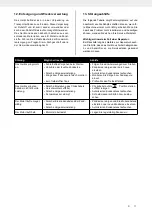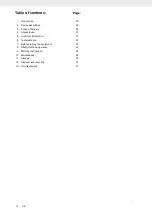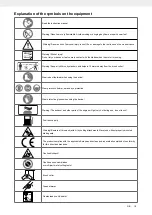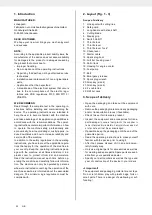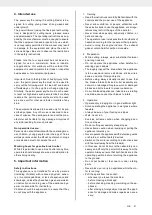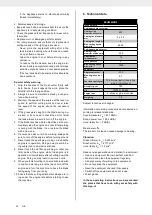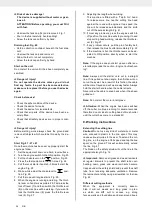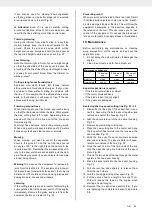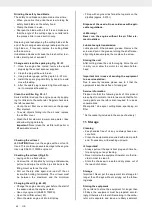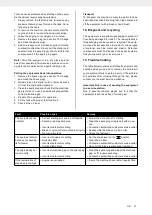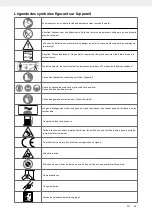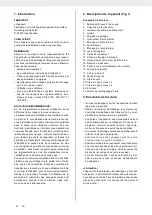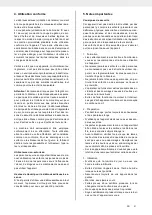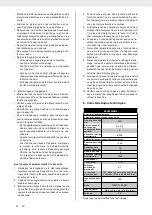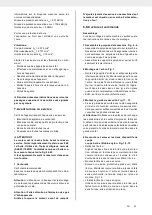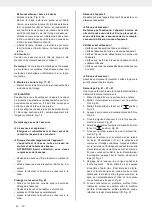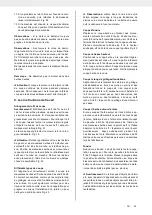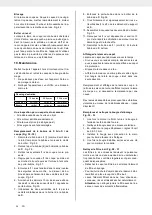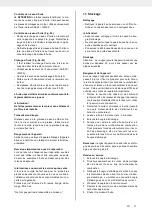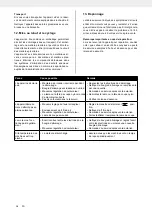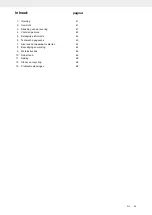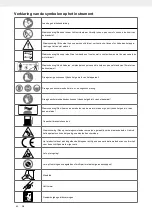
25
GB
It can also be used for „mowing“ down vegetation
so that a garden can be better prepared or a certain
area cleared down to the soil. Fig. 43
m
Attention:
Even if it is used carefully, cutting
around foundations, stone or concrete walls, etc. will
result in the line suffering more than normal wear.
Trimming/mowing
Swing the trimmer from side to side in a scything
motion. Always keep the line spool parallel to the
ground. Check the site and decide which cutting
height you require. Guide and hold the line spool at
the required height to obtain an even cut. Fig. 43
Low trimming
Hold the trimmer right in front of you at a slight angle
so that the underside of the line spool is above the
ground and the line strikes the correct target. Always
cut away from yourself. Never draw the trimmer to
-
wards yourself.
Cutting along fences/foundations
Approach wire mesh fences, lath fences, natural
stone walls and foundations slowly so that you can
cut close to them without striking the obstacle with
the line. If, for example, the line strikes stones, stone
walls or foundations, it will wear or fray. If the line
strikes wire fencing, it will break.
Trimming around trees
When trimming around tree trunks, approach slowly
so that the line does not strike the bark. Walk around
the tree, cutting from left to right. Approach grass or
weeds with the tip of the line and tilt the line spool
forwards slightly.
Warning! Take extreme care during mowing work.
When doing such work keep a distance of 30 meters
between yourself and other people or animals.
Mowing
When mowing, you want to cut all the vegetation
down to the ground. To do this, set the line spool at
an angle of 30° to the right. Place the handle in the
required position. Remember the increased risk of in-
jury to the user, watchers and animals, and the dan
-
ger of damaging property due to objects (for example
stones) being thrown.
Warning!
Do not use the equipment to remove ob-
jects from footpaths, etc. The equipment is a power-
ful tool and can throw small stones and other objects
a distance of 15 meters or more, causing injuries and
damage to cars, houses and windows.
Jamming
If the cutting blade jams as a result of attempting to
cut vegetation that is too dense, switch off the engine
immediately. Remove the grass and scrub from the
equipment before you restart it. Fig. 42
Preventing recoil
When you work with the blade, there is a risk of recoil
if it strikes solid objects such as tree trunks, branch-
es, tree stumps, stones or the like. This will throw the
equipment backwards in the direction opposite to
the rotation of the tool. This can cause you to lose
control of the equipment. Do not use the blade near
fences, metal posts, boundary stones or foundations.
10. Maintenance
Before performing any maintenance or cleaning
work, always turn off the engine and pull out the
spark boot plug
.
1.
Do not spray the unit with water. It damages the
engine.
2. Clean the unit with a cloth, hand brush, etc.
Maintenance schedule
12 hours of
use
24 hours of
use
36 hours of
use
Air filter
clean
clean
replace
Spark plug
check
clean
replace
Expert inspection is required:
• If the brush cutter strikes an object.
•
If the motor stops suddenly
• If the blade is bent (do not align!)
• If the gears are damaged.
Replacing the line spool/cutting line Fig. 35 - 39
1. Dismantle the line spool (1) as described in sec-
tion 8.4 Assembly. Press the spool together and
remove one half of the housing. Fig. 35
2. Take the spool plate out of the line spool housing.
Fig. 36
3.
Remove any remaining cutting line.
4. Place the new cutting line in the center and hang
the loop which has formed into the recess in the
spool splitter. Fig. 37
5. Wind the line onto the spool counter-clockwise
and under tension. The spool splitter will sepa-
rate the two halves of the line. Fig. 38
6. Hook the last 15 cm of the two ends of the line
onto the opposite lying line holders of the spool
plate. Fig. 39
7. Thread the two ends of the line through the metal
eyelets in the line spool housing .
8. Press the spool plate into the line spool housing.
Fig. 36
9.
Pull the two line ends sharply to release them
from the line holders.
10. Join the housing parts together again. Fig. 35
11. Cut the excess line to a length of around 13cm.
This will reduce the load on the engine when
starting and warming up.
12.
Remount the line spool (see section 8.4). If you
are replacing the complete line spool, skip points
3-6.







